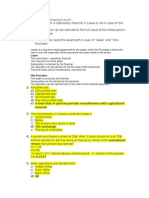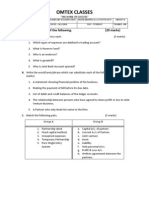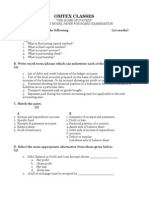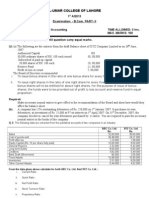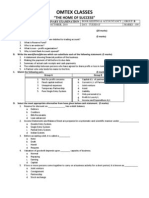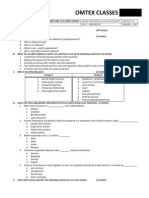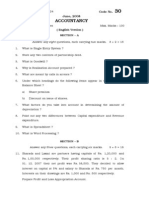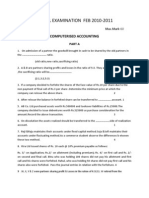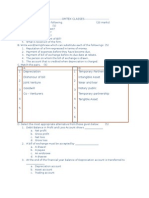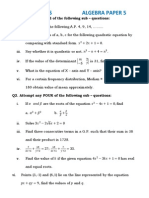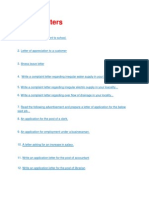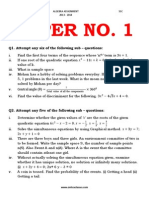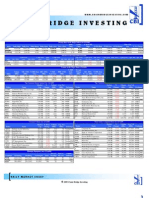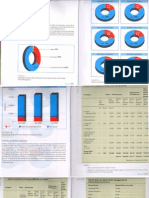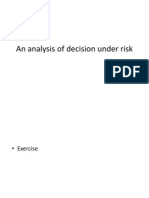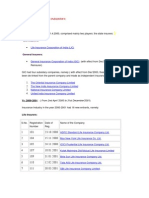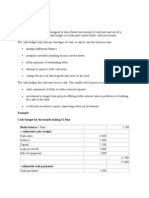0 ratings0% found this document useful (0 votes)
179 viewsAcconts Preliminary Paper 2
Acconts Preliminary Paper 2
Uploaded by
AMIN BUHARI ABDUL KHADERThis document contains accounting information for Omtex Classes' preliminary examination in bookkeeping and accountancy held on October 12, 2010. It includes questions on expenses debited to trading account, the meaning of reserve fund and endorser, examples of matching pairs related to accounting, selecting the appropriate accounting term, preparing a bill of exchange, journalizing transactions, solving problems related to joint ventures and preparing financial statements from a trial balance with additional information provided.
Copyright:
Attribution Non-Commercial (BY-NC)
Available Formats
Download as PDF, TXT or read online from Scribd
Acconts Preliminary Paper 2
Acconts Preliminary Paper 2
Uploaded by
AMIN BUHARI ABDUL KHADER0 ratings0% found this document useful (0 votes)
179 views13 pagesThis document contains accounting information for Omtex Classes' preliminary examination in bookkeeping and accountancy held on October 12, 2010. It includes questions on expenses debited to trading account, the meaning of reserve fund and endorser, examples of matching pairs related to accounting, selecting the appropriate accounting term, preparing a bill of exchange, journalizing transactions, solving problems related to joint ventures and preparing financial statements from a trial balance with additional information provided.
Original Description:
Uploaded from Google Docs
Copyright
© Attribution Non-Commercial (BY-NC)
Available Formats
PDF, TXT or read online from Scribd
Share this document
Did you find this document useful?
Is this content inappropriate?
This document contains accounting information for Omtex Classes' preliminary examination in bookkeeping and accountancy held on October 12, 2010. It includes questions on expenses debited to trading account, the meaning of reserve fund and endorser, examples of matching pairs related to accounting, selecting the appropriate accounting term, preparing a bill of exchange, journalizing transactions, solving problems related to joint ventures and preparing financial statements from a trial balance with additional information provided.
Copyright:
Attribution Non-Commercial (BY-NC)
Available Formats
Download as PDF, TXT or read online from Scribd
Download as pdf or txt
0 ratings0% found this document useful (0 votes)
179 views13 pagesAcconts Preliminary Paper 2
Acconts Preliminary Paper 2
Uploaded by
AMIN BUHARI ABDUL KHADERThis document contains accounting information for Omtex Classes' preliminary examination in bookkeeping and accountancy held on October 12, 2010. It includes questions on expenses debited to trading account, the meaning of reserve fund and endorser, examples of matching pairs related to accounting, selecting the appropriate accounting term, preparing a bill of exchange, journalizing transactions, solving problems related to joint ventures and preparing financial statements from a trial balance with additional information provided.
Copyright:
Attribution Non-Commercial (BY-NC)
Available Formats
Download as PDF, TXT or read online from Scribd
Download as pdf or txt
You are on page 1of 13
This document contains text automatically extracted from a PDF or image file.
Formatting may have
been lost and not all text may have been recognized.
To remove this note, right-click and select "Delete table".
OMTEX CLASSES
“THE HOME OF SUCCESS”
OMTEX CLASSES IST PRELIMINARY EXAMINATION BOOK KEEPING & ACCOUNTANCY
GROUP: B
TIME: - 3 HRS DATE: - 12 TH OCTOBER, 2010 DAY - TUESDAY MARKS: -100
Q1. Attempt any four of the following. (20 marks)
A. Answer in one sentence each. (5 marks)
1. Which types of expenses are debited to trading account?
2. What is Reserve Fund?
3. Who is an endorser?
4. What is non – profit organisation?
5. Why is Joint Bank Account opened?
B. Write the word/term/phrase which can substitute each of the following statement: (5 marks)
1. A statement showing financial position of the business.
2. Making the payment of bill before its due date.
3. Summary of actual cash receipts and cash payments.
4. The relationship between persons who have agreed to share profit or loss in Joint Venture Business.
5. A Partner who only lends his name to the firm.
C. Match the following pairs. (5 marks)
Group A Group B
1. Not for profit concerns
2. Fixed capital method.
3. Unexpired expenses
4. Temporary Partnership
5. Pure Single Entry System
a. Capital A/c. of partner.
b. Current A./c of Partner.
c. Joint venture
d. Asset
e. Liability
f. Only personal A/cs.
g. Profit & Loss A/c.
h. Income and Expenditure A/c.
D. Select the most appropriate alternative from hose given below each statement. (5 marks)
1. Reserve for discount on ______________ has a debit balance.
a. Debtors
b. Creditors
c. Bills Receivable
d. Loan advanced.
2. Income Statements and Balance Sheet are prepared in a systematic and scientific manner under
________________
a. Double Entry System.
b. Single Entry System
c. Partial Entry System.
d. Indian System.
3. Before accepting a bill, it is called a _________
a. Note
b. Draft
c. Hundi
d. Request.
4. Valuation of goodwill depends upon ________ capacity of business.
a. Normal
b. Repaying
c. Earning
d. Capital
5. If two or more persons come together to carry on a business activity for a short period, it is known as
___________
a. Joint venture
b. Consignment
c. Partnership
d. Stock exchange
OMTEX CLASSES
“THE HOME OF SUCCESS”
E. State with reason whether the following statements are true of false. (5 marks)
1. Scrap value of asset reduces the amount of annual depreciation.
2. When the amount of the bill is paid on the due date, it is said to be retired.
F. Prepare bill of exchange from the following details.
Drawer - Shekhar Desai, Shastri Road, Mahad. (5 marks)
Drawee – Sharad Verma, Narayan Peth, Pune.
Amount - Rs. 3500/-
Period - 3 months.
Payee - Mukund Pande, Panvel
Date of Bill Drawn – 21st June, 2007
Date of Acceptance - 23
rd
June, 2007
Q2. M/s Amol Industries, Pune, purchased machinery for Rs. 19,400 on 1
st
July 1976, additional machinery costing Rs. 10,000 was acquired. On 1
st
January, 1976, and spent Rs. 600 for its erection. On 1
st
January, 1976 was
sold for Rs. 12,000 and on the same date fresh machinery was purchased at a cost of Rs. 16,000.
Depreciation was provided annually
on 31
st
July 1978 the machinery purchased on 1
st
December at the rate of 10% on the original cost. Give the machinery account and deprecation account
for 1976, 1977 and
1978.
OR
Q2. (A) For the purpose of valuation of goodwill it was agreed to consider net profits of the last 4 years
and goodwill is to be
calculated at one year’s purchase of average net profits of last 4 years. The profits were
IST YEAR IIND YEAR IIIRD YEAR IVTH YEAR
Rs. 80,000 Rs. 90,000 Rs. 1,05,000 Rs. 1,10,000
Q2. (B) Name the two output devices of computers and explain them in brief:
Q3. Abha purchased goods from Prabha on credit for Rs. 10,000 and accepted a bill drawn by Prabha
for four months. Prabha
discounted the bill with her bank for Rs. 9,800. Before due date Abha accprached Prabha with a request
to renew the bill. Prabha
agreed but with the condition that Abha should pay Rs. 6,000 with interest of Rs. 150 and accept a new
bill for the balance. The
arrangements were duly carried out. New bill is met on due date. Pass the necessary journal entries in
the books of Prabha.
Q3. Journalize the following transactions in the books of Smita:
1. Nita informs Smita about dishonor of Anita’s acceptance endorsed to her by Smita for Rs. 15,000. Nita
paid noting charges
of Rs. 70.
2. Smita retired her acceptance for Rs. 7,000 one month before due date at a rebate of 12% p.a. to
Smita.
3. The bank informs Smita that Sudha’s acceptance for Rs. 8,000 sent to bank for collection has been
honoured. Bank charges
debited Rs. 160.
4. Our acceptance to Soni for Rs. 5100 is settled by endorsing Chitra’s acceptance to us for Rs. 4,950.
Q4. Yash and Jay entered into joint venture to purchase and sell cycles. They decided to share profit
and losses equally. Yash
purchased 150 cycles at Rs. 400 each and spent Rs. 2,000 for carriage Rs. 4,000 for insurance and
draws a bill for Rs. 35,000 on Jay,
which is duly accepted by Jay. Jay purchased 210 cycles at Rs. 400 each and spent Rs. 1,400 for
carriage and Rs. 2,000 for selling
expenses. Yash sold 180 cycles at Rs. 750 each. All the remaining cycles of venture were sold by Jay at
Rs. 550 each.
Joint venture was completed and both the parties settled their accounts you are required to prepare joint
venture account
and Jay’s account in the books of Yash.
OMTEX CLASSES
“THE HOME OF SUCCESS”
Q5. Mr. Suryakant maintains books on single entry and who gives you the following information.
Particulars 31-3-2006 31-3-2007
Cash in hand
Cash at bank
Stock
Sundry debtors
Investments
Furniture
Machinery
Sundry creditors
Outstanding expenses
500
2500
20000
25000
20000
10000
25000
10000
3000
2000
5000
30000
40000
20000
25000
40000
10000
2000
Additional information
1. Mr. Suryakant introduced further capital of Rs. 20000 on 1
st
July, 2006 and had withdrawn Rs. 10,000 during the year.
2. Interest on capital is allowed at 10% p.a.
3. Additions to furniture and machinery were made on 1
st
October, 2006
4. Write of deprecation on furniture and machinery at 10% p.a.
5. Create reserve for doubtful debts at 5% on sundry debtors.
Prepare: a. Statement of affairs. B. Statement of profit and loss for the year ended 31
st
March, 2007.
Q6. Dimple and Simple entered into a joint venture. They agreed to share profits and losses in the
proportion of their initial
contributions to the joint venture. They opened a joint Bank A/c. and deposited Rs. 60,000 and Rs.
40,000 respectively as initial
contributions. They made cash purchases of Rs. 70,000. They also paid Rs. 4,500 for insurance and
freight and Rs. 1,750 for sundry
expenses. At the end of the venture, the sales amounted to Rs. 1, 10,000/- There was unsold stock of
goods worth Rs. 5000. Simple
took over the unsold stock. The Joint Venture was closed. You are asked to prepare Joint Venture A/c.
Joint Bank A/c and Co –
ventures A/c.
OMTEX CLASSES
“THE HOME OF SUCCESS”
1. Q7. From the following Trial Balance of Shyam and Sundar, You are required to prepare a Trading
and Profit and Loss account for the
year ended 31
st
December, 2002 and Balance sheet as on that date after taking into consideration the additional
information. They
share profits and losses in their capital ratio.
Trial Balance as on 31
st
December, 2002
Particulars Amounts Particulars Amounts
Drawings:
Shyam
Sundar
Opening Stock
Purchases
Office Salaries
Royalties
Trade Expenses
Advertisement
Wages and Salaries
Cash in Hand
Debtors
Bad Debts
Investments
Motor Van
Furniture
Office Rent
Plant and Machinery
Freehold Property
Bills Receivable
Discount
Capital Accounts:
2, 000
Shyam
1, 000
Sundar
12, 000
Creditors
80, 000
Sales
6, 000
R.D.D
2, 000
Return Outwards
1, 400
Bills Payable
5, 200
Reserve Fund
10, 400
8, 000
50, 000
400
16, 000
30, 000
10, 000
3, 400
24, 000
16, 000
4, 000
1, 600
40, 000
60, 000
30, 000
1, 40, 000
1, 000
2, 400
6, 000
4, 000
2, 83, 400 2, 83, 400
Adjustments:
1. Closing stock was valued at Rs. 17, 600
2. Audit Fee for the year was outstanding Rs. 2, 400
3. Create R.D.D at 5% on Debtors.
4. The goods for Rs. 5, 600 purchased and received on 25
th
December, 2002 were not recorded in the purchase book.
5. Depreciate freehold property at 10% and Motor Van at 25%
You might also like
- Computerised Accounting Practice Set Using MYOB AccountRight - Advanced Level: Australian EditionFrom EverandComputerised Accounting Practice Set Using MYOB AccountRight - Advanced Level: Australian EditionNo ratings yet
- PAS 7 Reviewer (With Answers)Document5 pagesPAS 7 Reviewer (With Answers)John Ace Madriaga100% (1)
- Shariah Non Compliance Through Auditing and Risk ManagementDocument22 pagesShariah Non Compliance Through Auditing and Risk ManagementAzah Atikah Anwar BatchaNo ratings yet
- Inspired by FinanceDocument553 pagesInspired by FinanceIlirjan Cane100% (1)
- BFS L0 QuesDocument360 pagesBFS L0 QuesShubhamKaseraNo ratings yet
- Accounts Preliminary Paper No 9 PDFDocument6 pagesAccounts Preliminary Paper No 9 PDFAMIN BUHARI ABDUL KHADERNo ratings yet
- Accounts Preliminary Paper No 8Document6 pagesAccounts Preliminary Paper No 8AMIN BUHARI ABDUL KHADERNo ratings yet
- ADL 03 Ver2+Document6 pagesADL 03 Ver2+DistPub eLearning SolutionNo ratings yet
- Omtex Classes: "The Home of Success"Document4 pagesOmtex Classes: "The Home of Success"AMIN BUHARI ABDUL KHADERNo ratings yet
- Accounting For Managers MB003 QuestionDocument34 pagesAccounting For Managers MB003 QuestionAiDLo0% (1)
- Accounts Preliminary Paper No 1 2009 - 2010Document5 pagesAccounts Preliminary Paper No 1 2009 - 2010AMIN BUHARI ABDUL KHADERNo ratings yet
- Accounts Paper Ii PDFDocument6 pagesAccounts Paper Ii PDFAMIN BUHARI ABDUL KHADERNo ratings yet
- XII AccountancyDocument4 pagesXII AccountancyAahna AcharyaNo ratings yet
- Accounts Question Paper Omtex ClassesDocument8 pagesAccounts Question Paper Omtex ClassesAmin Buhari Abdul KhaderNo ratings yet
- Al-Umar College of Lahore: ABC Co. Ltd. Rs. XYZ Co. Ltd. RsDocument3 pagesAl-Umar College of Lahore: ABC Co. Ltd. Rs. XYZ Co. Ltd. RsXaXim XhxhNo ratings yet
- Unit Test AcDocument2 pagesUnit Test AcRamnarayan DarakNo ratings yet
- Bba 3 Sem AccountsDocument9 pagesBba 3 Sem Accountsanjali LakshcarNo ratings yet
- Module-2 Sample Question PaperDocument18 pagesModule-2 Sample Question PaperRay Ch100% (1)
- BK Paper 45 MarksR3 PrelimDocument5 pagesBK Paper 45 MarksR3 Prelimpsawant770% (1)
- 43 RTP Pe2 Nov07 gp1Document107 pages43 RTP Pe2 Nov07 gp1P VenkatesanNo ratings yet
- Class 11 Accountancy Worksheet - 2023-24Document17 pagesClass 11 Accountancy Worksheet - 2023-24Yashi BhawsarNo ratings yet
- Acconts Preliminary Paper 2Document4 pagesAcconts Preliminary Paper 2AMIN BUHARI ABDUL KHADERNo ratings yet
- Model Accounts Question PaperDocument4 pagesModel Accounts Question PaperAMIN BUHARI ABDUL KHADERNo ratings yet
- Test 1Document105 pagesTest 1PrathibaVenkatNo ratings yet
- TH TH STDocument3 pagesTH TH STsharathk916No ratings yet
- CBSE Class 11 Accountancy Worksheet - Question BankDocument17 pagesCBSE Class 11 Accountancy Worksheet - Question BankUmesh JaiswalNo ratings yet
- Alagappa University DDE BBM First Year Financial Accounting Exam - Paper2Document5 pagesAlagappa University DDE BBM First Year Financial Accounting Exam - Paper2mansoorbariNo ratings yet
- Accounting Final Sendup 2013Document3 pagesAccounting Final Sendup 2013Mozam MushtaqNo ratings yet
- 438Document6 pages438Rehan AshrafNo ratings yet
- Accounting GuessDocument5 pagesAccounting GuessjhouvanNo ratings yet
- Accounts Paper I PDFDocument6 pagesAccounts Paper I PDFAMIN BUHARI ABDUL KHADERNo ratings yet
- Accounts Final Exam of BCADocument6 pagesAccounts Final Exam of BCAAtul Kumar100% (1)
- 11 Accountancy Sample Paper 01Document5 pages11 Accountancy Sample Paper 01Ritu GuptaNo ratings yet
- Accountancy Model QuestionsDocument19 pagesAccountancy Model QuestionsSunil Kumar AgarwalaNo ratings yet
- CBSE Class 12 Accountancy Sample Paper-02 (For 2012)Document20 pagesCBSE Class 12 Accountancy Sample Paper-02 (For 2012)cbsesamplepaperNo ratings yet
- 2015 11 SP Accountancy Solved 04 PDFDocument4 pages2015 11 SP Accountancy Solved 04 PDFcerlaNo ratings yet
- Unit-I: DepreciationDocument4 pagesUnit-I: DepreciationEswari GkNo ratings yet
- Isc Accounts 5 MB: (Three HoursDocument7 pagesIsc Accounts 5 MB: (Three HoursShivam SinghNo ratings yet
- CBSE Class 12 Accountancy Sample Paper-01 (For 2013)Document7 pagesCBSE Class 12 Accountancy Sample Paper-01 (For 2013)cbsestudymaterialsNo ratings yet
- Extra AfaDocument5 pagesExtra AfaJesmon RajNo ratings yet
- Questions Accounting For Departments: Revision Test Paper Cap-Ii: Advanced AccountingDocument27 pagesQuestions Accounting For Departments: Revision Test Paper Cap-Ii: Advanced AccountingcasarokarNo ratings yet
- FA (2010) MidtermDocument16 pagesFA (2010) MidtermRishi BiggheNo ratings yet
- Quest 1Document7 pagesQuest 1btetarbeNo ratings yet
- Mock TestDocument3 pagesMock Testnidhi_020633677No ratings yet
- Accountancy June 2008 EngDocument8 pagesAccountancy June 2008 EngPrasad C MNo ratings yet
- Unit V-Cash ManagementDocument15 pagesUnit V-Cash ManagementLeemaRosaline SimonNo ratings yet
- Model Examination Feb 2010-2011: Computerised AccountingDocument3 pagesModel Examination Feb 2010-2011: Computerised Accountingsharathk916No ratings yet
- Class 12 Cbse Accountancy Sample Paper 2012 Model 2Document20 pagesClass 12 Cbse Accountancy Sample Paper 2012 Model 2Sunaina RawatNo ratings yet
- CBSE Class 11 Accountancy Question Paper SA 2 2013 PDFDocument6 pagesCBSE Class 11 Accountancy Question Paper SA 2 2013 PDFsivsyadavNo ratings yet
- Accountancy: Time Allowed: 3 Hours Maximum Marks: 80Document58 pagesAccountancy: Time Allowed: 3 Hours Maximum Marks: 809chand3No ratings yet
- Acounts Papaer II Preliminary Examination 2008 - 09Document5 pagesAcounts Papaer II Preliminary Examination 2008 - 09AMIN BUHARI ABDUL KHADERNo ratings yet
- SAMPLE PAPER - (Solved) : For Examination March 2017Document13 pagesSAMPLE PAPER - (Solved) : For Examination March 2017ankush yadavNo ratings yet
- Assigment BBM Finacial AccountingDocument6 pagesAssigment BBM Finacial Accountingtripathi_indramani5185No ratings yet
- Higher Secondary Examination March 2011: Accoutancy With Computerised AccountingDocument2 pagesHigher Secondary Examination March 2011: Accoutancy With Computerised Accountingsharathk916No ratings yet
- PAC All CAF Subjects Mocks With Solutions Regards Saboor AhmadDocument164 pagesPAC All CAF Subjects Mocks With Solutions Regards Saboor AhmadTajammal CheemaNo ratings yet
- Accounting Long Questions II YearDocument10 pagesAccounting Long Questions II Yeararshad aliNo ratings yet
- HSC Accounts Model Question Paper For Board ExamDocument6 pagesHSC Accounts Model Question Paper For Board ExamAMIN BUHARI ABDUL KHADERNo ratings yet
- QB Ii PDFDocument45 pagesQB Ii PDFabid hussainNo ratings yet
- Income Tax Law for Start-Up Businesses: An Overview of Business Entities and Income Tax LawFrom EverandIncome Tax Law for Start-Up Businesses: An Overview of Business Entities and Income Tax LawRating: 3.5 out of 5 stars3.5/5 (4)
- Cambridge Made a Cake Walk: IGCSE Accounting theory- exam style questions and answersFrom EverandCambridge Made a Cake Walk: IGCSE Accounting theory- exam style questions and answersRating: 2 out of 5 stars2/5 (4)
- Your Amazing Itty Bitty® Book of QuickBooks® TerminologyFrom EverandYour Amazing Itty Bitty® Book of QuickBooks® TerminologyNo ratings yet
- 21St Century Computer Solutions: A Manual Accounting SimulationFrom Everand21St Century Computer Solutions: A Manual Accounting SimulationNo ratings yet
- Personality Development PDFDocument7 pagesPersonality Development PDFAMIN BUHARI ABDUL KHADER80% (5)
- Political Science: Try This Question Paper As Per New SyllabusDocument2 pagesPolitical Science: Try This Question Paper As Per New SyllabusAMIN BUHARI ABDUL KHADERNo ratings yet
- Algebra Question Paper 5 PDFDocument3 pagesAlgebra Question Paper 5 PDFAMIN BUHARI ABDUL KHADERNo ratings yet
- Algebra Home Work PDFDocument6 pagesAlgebra Home Work PDFAMIN BUHARI ABDUL KHADERNo ratings yet
- Formal LettersDocument9 pagesFormal LettersAMIN BUHARI ABDUL KHADER100% (2)
- Algebra Question Paper For Practise: 1. Attempt Any Five Sub - QuestionsDocument3 pagesAlgebra Question Paper For Practise: 1. Attempt Any Five Sub - QuestionsAMIN BUHARI ABDUL KHADERNo ratings yet
- Trigonometry and Mensuration FormulaeDocument2 pagesTrigonometry and Mensuration FormulaeAMIN BUHARI ABDUL KHADERNo ratings yet
- Science Unit Test Paper PDFDocument3 pagesScience Unit Test Paper PDFAMIN BUHARI ABDUL KHADER100% (1)
- Science and Technology Paper I PDFDocument2 pagesScience and Technology Paper I PDFAMIN BUHARI ABDUL KHADERNo ratings yet
- Geometry Homework PDFDocument3 pagesGeometry Homework PDFAMIN BUHARI ABDUL KHADERNo ratings yet
- Algebra Question Paper For Practise PDFDocument7 pagesAlgebra Question Paper For Practise PDFAMIN BUHARI ABDUL KHADER0% (1)
- Personality Development PDFDocument7 pagesPersonality Development PDFAMIN BUHARI ABDUL KHADER80% (5)
- Algebra Question Paper For Practise: 1. Attempt Any Five Sub - QuestionsDocument3 pagesAlgebra Question Paper For Practise: 1. Attempt Any Five Sub - QuestionsAMIN BUHARI ABDUL KHADERNo ratings yet
- Secretarial Practice Paper I PDFDocument2 pagesSecretarial Practice Paper I PDFAMIN BUHARI ABDUL KHADERNo ratings yet
- Algebra Question Paper 5 PDFDocument3 pagesAlgebra Question Paper 5 PDFAMIN BUHARI ABDUL KHADERNo ratings yet
- Accounts Paper I PDFDocument6 pagesAccounts Paper I PDFAMIN BUHARI ABDUL KHADERNo ratings yet
- Admission Form 2014 OMTEX CLASSESDocument1 pageAdmission Form 2014 OMTEX CLASSESAMIN BUHARI ABDUL KHADERNo ratings yet
- Algebra Question Paper 2Document2 pagesAlgebra Question Paper 2AMIN BUHARI ABDUL KHADERNo ratings yet
- Accounts Paper Ii PDFDocument6 pagesAccounts Paper Ii PDFAMIN BUHARI ABDUL KHADERNo ratings yet
- Omtex Classes: Q1. Attempt Any Six of The Following Sub - Questions. (6 Marks)Document2 pagesOmtex Classes: Q1. Attempt Any Six of The Following Sub - Questions. (6 Marks)AMIN BUHARI ABDUL KHADERNo ratings yet
- Omtex Classes: Q1. Attempt Any Six of The Following Sub - Questions. (6 Marks)Document2 pagesOmtex Classes: Q1. Attempt Any Six of The Following Sub - Questions. (6 Marks)AMIN BUHARI ABDUL KHADERNo ratings yet
- English L.L. Preliminary PapeDocument4 pagesEnglish L.L. Preliminary PapeAMIN BUHARI ABDUL KHADERNo ratings yet
- Soneri Bank Limited1Document14 pagesSoneri Bank Limited1Anonymous YkMptv9jNo ratings yet
- Bharti Airtel AnalysisDocument4 pagesBharti Airtel AnalysisRockNo ratings yet
- Internal Order Accounting2Document39 pagesInternal Order Accounting2Ibbu MohdNo ratings yet
- Jonathan Barrett Resume - Harlem Link Charter School Board Application - Vol 2 of 3 - PG 431-432Document2 pagesJonathan Barrett Resume - Harlem Link Charter School Board Application - Vol 2 of 3 - PG 431-432Fuzzy PandaNo ratings yet
- Marriott - Sales ManagmentDocument10 pagesMarriott - Sales ManagmentDeepak JoshiNo ratings yet
- Daily Market Sheet 12-14-09Document2 pagesDaily Market Sheet 12-14-09chainbridgeinvestingNo ratings yet
- CF Financial Analysis - Group 10Document31 pagesCF Financial Analysis - Group 10Nguyen Quy Tran TranNo ratings yet
- Industry Analysis FinalDocument18 pagesIndustry Analysis FinalManaf BasheerNo ratings yet
- Euro Zone Crisis QDocument70 pagesEuro Zone Crisis Qtarungupta2001No ratings yet
- INFINITIDocument11 pagesINFINITIapi-3757629100% (1)
- Management Advisory ServicesDocument10 pagesManagement Advisory ServicesMark ArceoNo ratings yet
- FR111. (F.L) Solution CMA January-2023 Exam.Document6 pagesFR111. (F.L) Solution CMA January-2023 Exam.Shawn MehdiNo ratings yet
- RP-UK Tax TreatyDocument26 pagesRP-UK Tax TreatyJulie AnnNo ratings yet
- Regional Sales Manager Operations in Houston TX Resume Thomas BarrettDocument2 pagesRegional Sales Manager Operations in Houston TX Resume Thomas BarrettThomasBarrettNo ratings yet
- AVentures Capital Invests in Viseven, A Fast-Growing Digital Solution Provider For The Pharmaceutical and Life Sciences Enterprise CompaniesDocument2 pagesAVentures Capital Invests in Viseven, A Fast-Growing Digital Solution Provider For The Pharmaceutical and Life Sciences Enterprise CompaniesPR.comNo ratings yet
- MQP - MBA - Sem2 - Financial Management (DMBA202) PDFDocument4 pagesMQP - MBA - Sem2 - Financial Management (DMBA202) PDFsanjeev misraNo ratings yet
- Session 4 Prospect TheoryDocument41 pagesSession 4 Prospect TheoryLokesh Khatwani50% (2)
- Startup and New Venture Management Module - 1: Content Prepared by Prof. Chinmoy GoswamiDocument26 pagesStartup and New Venture Management Module - 1: Content Prepared by Prof. Chinmoy GoswamiChandan MahantoNo ratings yet
- CVP AnalysisDocument8 pagesCVP AnalysisshishirjNo ratings yet
- Jaggery From Sugar CaneDocument4 pagesJaggery From Sugar CaneMichael Odiembo100% (1)
- Bank AwarnessDocument748 pagesBank Awarnessਅਮਨਦੀਪ ਸਿੰਘ ਰੋਗਲਾNo ratings yet
- C.V. - Dr.S.VELAYUTHAMDocument9 pagesC.V. - Dr.S.VELAYUTHAMManickam GajapathyNo ratings yet
- Indian History of InsuranceDocument6 pagesIndian History of InsuranceJeyarajasekar TtrNo ratings yet
- Budjet and PlannigDocument10 pagesBudjet and Plannigprakash009kNo ratings yet
- Nivea Review FinalDocument6 pagesNivea Review FinalLaura GaxiolaNo ratings yet




